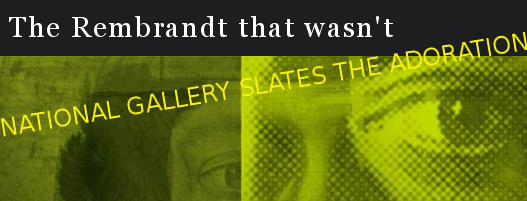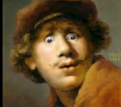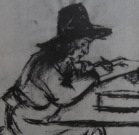| REMBRANDT BEYOND THE 20TH CENTURY A real reason to rejoice on Rembrandt's 400th birthday. |
REMBRANDT BEYOND THE 20TH CENTURY A real reason to rejoice on Rembrandt's 400th birthday.
SYNOPSIS:THE 20TH CENTURY INTRODUCED MANY REVOLUTIONARY IDEAS INTO ART. THE NEW CRITICAL THEORIES ARE ENSHRINED IN WOLFFLIN'S "THE PRINCIPLES OF ART HISTORY". HE AND HIS FOLLOWERS HAVE CONSCIOUSLY OR SUBCONSCIOUSLY WANTED TO RECRUIT THE GREAT REMBRANDT INTO THIS NEW SYSTEM OF BELIEFS BUT REMBRANDT'S WHOLE PHILOSOPHY AND ARTISTIC MAKE-UP DO NOT FIT. THE REMBRANDT CRITICS ARE TRYING TO FORCE A SQUARE PEG INTO A ROUND HOLE. THEY ARE DESTROYING HIM AND MUST BE STOPPED. In the 20th century and the beginning of this century Rembrandt critics have been more restrictive than ever before with both Rembrandt's paintings and drawings. They accuse him of signing works that they think were not genuinely his; naturally this reflects on his character and general trustworthiness. They have reduced the number of accepted Rembrandt paintings by approximately 70% and the drawings by nearly 50%. With the help of new computer technology (Job) we will demonstrate how the acknowledged experts have made many grave errors in their assessment of the master. In less than an hour of DVD Presentations, we can show, the errors that have caused his eclipse (see note 1.). Rembrandt is perhaps the greatest of all artists; certainly the most relevant old master to the modern world. Rembrandt, like his contemporaries in the world of science, marks the turning point where the modern era begins. His philosophy of art is therefore very important to us. It has been turned upside down by the attempt to adapt him to the modern creed. The history of the misinterpretation of Rembrandt goes back to 1915 when Heinrich Wolfflin published the book 'The Principles of Art History'. His principles have dominated art-history and art-historical training ever since. He proposed a new approach to art criticism that was to keep up with Cubism and other art movements of that time. It was an approach that looked at the abstract qualities of a work and not at the human aspect. In Rembrandt's art the human aspect, the interaction between his figures, brilliantly rendered by Rembrandt's unique spacial sense - his understanding of the human condition, and his ability to observe human nature and respond to it with profound empathy, are what make Rembrandt the genius he is. To misinterpret, or miss alltogether the humanity in Rembrandt's work is to lose sight of his genius and to miss the whole point. In The Virgin and Child section, we will see a mother exhausted by mothering. It is not the usual 'Virgin and Child' relationship of "Art". However Rembrandt is showing us an important truth about mothering. Rembrandt life's experience (losing children and eventually his beloved wife as well) is the larger subject of this drawing. But the Rembrandt specialist does not see Rembrandt's humanity, he sees 'lines of splintery angularity' and disapproves! History-painting was regarded as the highest ambition for a painter prior to Wolfflin. Rembrandt spent most of his time and energy on biblical subjects (history-painting). To check out Rembrandt's brilliant interpretation of the Bible see:- The Death-bed of David. Reading Wolfflin's book you can see why scholars have gone so very wrong. The scholars are concerned to create a smooth evolution for Rembrandt so they have dated his drawings according to superficial style. The experts believe that the biblical scenes you will see (in Mirrors) were drawn by Rembrandt and came from his imagination (out of his head). We will be showing that quite the opposite was true of Rembrandt. Rembrandt posed groups of models, drawing from life. He had an obvious abhorrence of working from imagination (see Imagination for the documentary evidence ). In this section we also demonstrate the huge difference in quality we have to expect between Rembrandt as the observer and Rembrandt as the inventor. When he had reality to observe he was incomperable. When he was forced by circumstance to invent, we feel his disinterest/even scorn. When scholars come to accept this difference they will have to reverse their recent deattributions. We may hope in time that Rembrandt will recover his status as an admirably honest artist. >
In the Mirrors section we demonstrate that the stylistic dating system is wrong.
|









